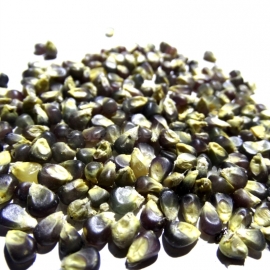


«Hopi Blue» - Organic Corn Seeds
1.14 €
Considered a staple corn of the Hopi people, this corn can be eaten as a sweet corn when young, or allowed to dry it can be used to make flour. Hopi Blue has a higher protein content than a dent corn and makes wonderful tortillas.
-
Organic Corn «Hopi Blue»
Considered a staple corn of the Hopi people, this corn can be eaten as a sweet corn when young, or allowed to dry it can be used to make flour.
Hopi Blue has a higher protein content than a dent corn and makes wonderful tortillas. The 7 inch, dried blue ears also make great autumn decorations. Plants are 5-6 feet tall.
How to Grow
Corn needs a spot with that gets full sun and has fertile, well-drained soil with a pH of 6.0 to 6.8. Seedlings can be set out as soon as the last spring frost has passed. Space plants 8 to 12 inches apart. In case of a surprise late frost, be prepared to cover seedlings with a fabric row cover. In cold climates you can plant in a raised bed covered with black or IRT plastic (infrared transmitting plastic) that will warm the soil. If possible, lay the plastic a week or so before planting.
Plan to fertilize twice because corn is a hungry plant. Before setting out seedlings, amend the soil with compost and mix a balanced organic or timed-release fertilizer into the soil. About a cup of 10-10-10 per 10 feet of row is a good general rate, but be sure to check and follow rates given on the label of any fertilizer you are using. About 6 weeks or so later, when the plants start to produce tassels, fertilize them again. (If you amend the soil with cottonseed meal or other high-nitrogen amendment, it may not be necessary to feed the second time.)
Use a hoe or trowel to mix the fertilizer into the top inch of soil between the plants. After this booster feeding, water your corn once or twice weekly if the weather is hot and dry. Normal plants should grow fast with dark green healthy leaves. Corn will tell you if it is hungry by turning very light green. If so, feed again.
Corn grows fast and needs lots of water to grow properly. It also has shallow roots that make it susceptible to drought. Soaker hoses will insure that your corn gets the water it needs. However, for a large planting, soaker hoses may not be practical.
